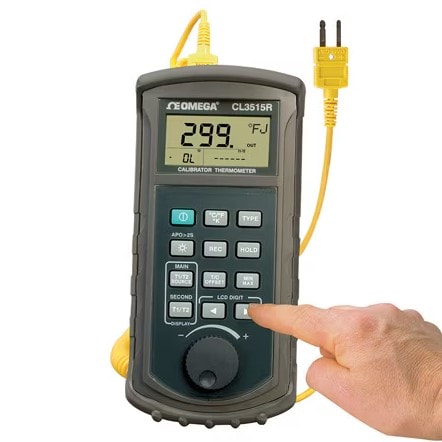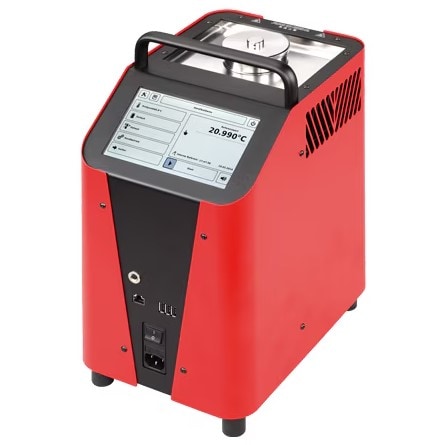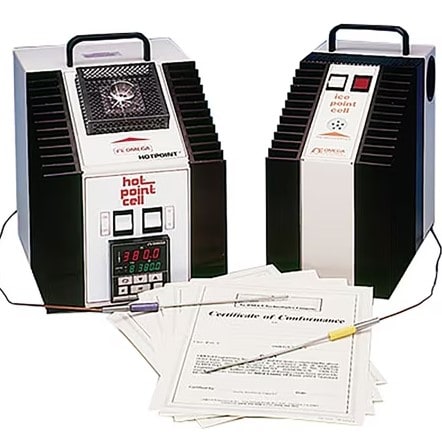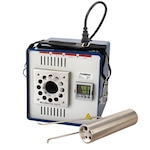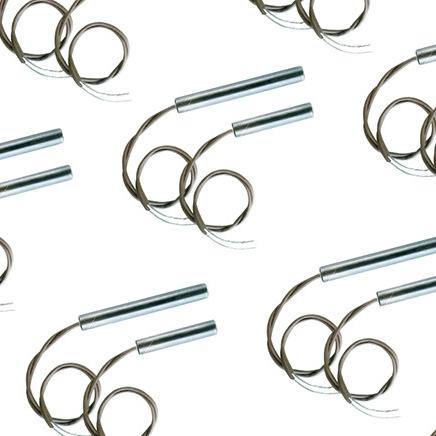Accurate temperature measurement plays a vital role in everything from industrial manufacturing to building management. With processes like managing production lines, overseeing HVAC systems, or monitoring research equipment, temperature data can play a key role in keeping things safe, efficient, and compliant. How is this data obtained, you might be asking. Temperature measurement devices, of course. But over time, even the most reliable sensors will begin to drift.
That’s why regular calibration is so important. Calibration helps ensure that your instruments continue to deliver precise, trustworthy readings. However, it is important to understand that not all calibration tools serve the same purpose. Some are designed to test the sensors themselves, while others are used to verify the performance of devices that interpret sensor signals. Knowing the difference between these two approaches helps ensure you're using the right tool for the job—and achieving the level of accuracy your application requires.
Simulators vs. Physical Calibration Devices: What's the Difference?
In temperature measurement systems, calibration ensures accuracy across both the sensing elements and the instruments that interpret sensor signals. Depending on what you're verifying—the sensor or the system reading the sensor—different calibration tools are used.
Temperature Signal Simulators
A temperature signal simulator mimics the electrical characteristics of temperature sensors such as thermocouples and RTDs. These devices are not concerned with heat—they simulate voltage (in millivolts) or resistance (in ohms) corresponding to a specific temperature. This allows engineers to test or calibrate instruments that process sensor signals, such as:
By simulating known temperature values, you can verify that these instruments correctly interpret and display readings, apply cold junction compensation, and handle scaling appropriately.
Physical Temperature Calibration Devices (Temperature Calibrators)
In contrast, physical calibration devices generate a stable, known temperature environment. These are used to calibrate the sensors themselves—verifying that a thermocouple, RTD, or infrared thermometer provides accurate readings in response to real temperature exposure.
Types of Temperature Calibrators
Temperature calibrators are available in a range of styles, each suited to specific applications, sensor types, and accuracy requirements. The most used types include:
Calibration Baths
Best For: Immersion-style sensors such as thermometers, RTDs, and thermocouples.
Calibration baths create a stable, uniform temperature environment ideal for high-accuracy calibration. They’re commonly used in labs, production facilities, and field testing where precision is essential. Two widely used types include dry block/micro-bath calibrators and fluidized sand baths.
Dry Block and Micro-Bath Calibrators
Dry block and micro-bath calibrators offer fast, reliable calibration in both portable and lab settings. These units cover wide temperature ranges and support internal or external sensor control, making them suitable for a variety of sensors and applications.
Models Available:
- TCL-650S-D: Dry block, ambient to 650 °C (1202 °F)
- TCL-165S-D / TCL-M165S-B: –35 °C to 165 °C (–31 °F to 329 °F)
- TCL-M255S-B: Micro bath, ambient to 255 °C (491 °F)
Key Features:
- Stability: ±0.05 °C
- Touchscreen display with 0.001 °C resolution
- Switchable °C/°F display
- NIST-traceable calibration certificate included
These calibrators are ideal for detecting sensor drift and maintaining accuracy over time. Compact, rugged designs make them easy to use in multiple test environments.
Ice Point Calibrators
Best For: Thermocouple cold junction reference and 0°C calibration of sensors.
Ice point calibrators provide a highly stable 0°C reference, ideal for cold junction compensation and precise sensor calibration. Unlike traditional ice baths, these chambers use thermoelectric cooling to maintain continuous equilibrium between ice and water—ensuring accuracy, repeatability, and ease of use in industrial, lab, or field settings.
TRCIII-Series High Precision Calibration-Temperature Reference Chamber
This fixed-location calibrator uses a sealed chamber of deionized water and ice, regulated by thermoelectric elements and an internal bellows mechanism. The system automatically freezes and thaws to maintain a constant 0°C across six reference wells, eliminating the drift and maintenance issues of manual ice baths.
Key Features:
- Precise 0 °C reference with ±0.1 °C accuracy and ±0.04 °C stability
- Supports all thermocouple types and general temperature sensors
- Ideal for cold junction compensation and 0 °C sensor calibration
- Pilot light indicates stable operation
- NIST-traceable calibration certificate available
Portable Ice Point Chamber (TRCIII-A)
The TRCIII-A offers the same stable 0 °C reference as the TRCIII but in a rugged, portable design with added digital display. It accommodates up to six probes simultaneously and includes a built-in temperature readout with 0.1° resolution.
Key Features:
- Compact, durable design for lab or field use
- Accepts up to six probes
- Built-in digital display (°C/°F switchable)
- NIST-traceable calibration certificate included
These chambers provide a modern, maintenance-free solution to replace traditional ice baths—ideal for accurate, repeatable sensor calibration in demanding environments.
Surface Plate Calibrator
Best For: Sufrace probes and flat-contact temperature sensors.
Surface plate calibrators provide a stable, flat temperature reference, making them ideal for verifying surface probe accuracy. These tools are especially useful for quality control in industrial, lab, or R&D environments where surface contact measurement plays a critical role.
CL1600 Surface Probe Tester
The CL1600 is a high-precision surface plate calibrator designed for periodic in-house testing and preventive maintenance of surface temperature sensors. Its mirror-finished aluminum alloy plate ensures fast, uniform heating across the entire surface, with an adjustable temperature range from 35 °C to 450 °C (95 °F to 842 °F).
Key Features:
- Temperature range: 35 °C to 450 °C (95 °F to 842 °F)
- Large 124 mm (4.875") aluminum surface plate
- Uniformity: ±0.4 °C at 100 °C, up to ±1.7 °C at 450 °C
- °C/°F switchable digital display with PID auto-tune control
- Stabilization in 15 minutes; full heat-up in 30 minutes
- Compact and portable: 3.4 kg (7.5 lb)
The built-in PID controller ensures accurate, consistent temperature regulation, while the durable construction makes it suitable for both bench-top calibration labs and factory settings.
DryBlock Calibrator
Best For: Thermocouples, RTDs, and thermistors in lab or field settings.
Dry block calibrators offer a clean, fast, and highly stable method for calibrating temperature sensors without the use of liquids. These compact systems use precisely controlled metal blocks to generate a consistent temperature source, making them ideal for both benchtop and portable applications.
DBCL400 Dry Block Calibrator
The DBCL400 delivers stable, dry temperature control from 5 °C above ambient up to 450 °C (850 °F), making it suitable for a wide range of industrial and laboratory calibration tasks. It features a machined aluminum block for efficient heat transfer and includes built-in over-temperature protection.
Key Features:
- Temperature range: Ambient +5 °C to 450 °C (850 °F)
- Fast heat-up: 25 °C to 400 °C in 12 minutes
- Over-temperature cutout at 470 °C (875 °F)
- Lightweight and portable: 5 kg (11 lb)
- Ideal for use on benchtops or in the field
DBCL-130 Dry Block Calibrator
Designed for low-temperature applications, the DBCL-130 spans from –25 °C to +130 °C (–13 °F to 266 °F) using a precision-machined aluminum block. It offers excellent stability and allows users to store and recall up to eight setpoints for repeatable testing.
Key Features:
- Temperature range: –25 °C to +130 °C (–13 °F to 266 °F)
- Compact and portable: 6.8 kg (15 lb)
- Includes standard insert and ¼" diameter reference well
- Stores up to 8 setpoints for quick recall
Both models offer reliable, dry calibration for a wide range of sensors, helping maintain measurement accuracy in production and QA environments.
Blackbody Calibrators
Best For: Infrared thermometers and thermal imaging systems.
Blackbody calibrators provide a precise temperature reference for non-contact devices by simulating known infrared emissions. These systems are essential for validating the accuracy of IR thermometers and thermal cameras in labs, industrial environments, and research facilities.
BB-4A High-Temperature Blackbody Calibrator
The BB-4A offers an adjustable temperature range from 100 °C to 982 °C (212 °F to 1800 °F), with ±1 °C accuracy and ±0.25% reading precision. It features a heated cavity with known emissivity, ideal for calibrating infrared pyrometers with spot sizes under 22 mm (0.88").
Key Features:
- Temperature range: 100 °C to 982 °C (212 °F to 1800 °F)
- Accuracy: ±1 °C or ±0.25% of reading
- Built-in digital PID temperature controller
- RS-232 interface for automated test setups
- NIST-traceable calibration certificate included
- Compact and portable design for bench or field use
BB701 Hot/Cold Blackbody Calibrator
The BB701 spans a broader range, from –18 °C to 149 °C (0 °F to 300 °F), making it ideal for both hot and cold calibration points. Its stable reference plate supports spot sizes up to 63.5 mm (2.5") and eliminates the need for ice bath setups.
Key Features:
- Temperature range: –18 °C to 149 °C (0 °F to 300 °F)
- Large-diameter emissive target plate
- Fast, accurate calibration of most IR pyrometers
- Digital PID controller with built-in display
- RS-232 interface and NIST-traceable certificate included
- Rugged, portable housing for flexible use
